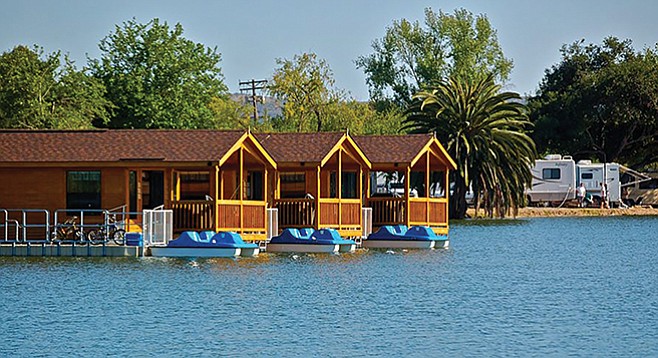 Facebook
Facebook
 X
X
 Instagram
Instagram
 TikTok
TikTok
 Youtube
Youtube

The seven small lakes called Santee Lakes began as part of a recycling plant. In 1960, the district started recycling wastewater for irrigation and commercial uses. The seven lakes were at the end of that treatment process.
Today, the park holds 194 acres. Fishing is allowed at all seven lakes, though lakes 6 and 7 are reserved for those at the 300 full hook-up campsites or renting cabins.
Some 35,000 pounds of fish is stocked in the lakes every year; about half trout, the other half channel catfish in plants spread throughout each season. Largemouth bass, carp, and bluegill also swim in the lakes. Catch-and-release is required on bass, though trout and carp must be kept. Releasing catfish and bluegill is optional, and there is a five-fish bag limit on all species combined. There is no limit on carp, as they are considered an invasive nuisance — the park may even offer incentive for their removal.
I have had mixed success fishing the string of ponds. At times, a fly-lined nightcrawler will get you there for any species targeted.
The park features playgrounds, hiking trails, pontoon boats, and floating rental cabins with decks you can fish from.
This weekend, Santee Lakes will be holding their annual Catfish Opener with a plant of 2000 pounds of catfish, including tagged fish worth tackle boxes, fishing rods, bicycles, camping gear, and free passes to Santee Lakes. State fishing license is not required, though a Santee Lakes fishing permit is. Prizes will be awarded for top-five largest catfish.


The seven small lakes called Santee Lakes began as part of a recycling plant. In 1960, the district started recycling wastewater for irrigation and commercial uses. The seven lakes were at the end of that treatment process.
Today, the park holds 194 acres. Fishing is allowed at all seven lakes, though lakes 6 and 7 are reserved for those at the 300 full hook-up campsites or renting cabins.
Some 35,000 pounds of fish is stocked in the lakes every year; about half trout, the other half channel catfish in plants spread throughout each season. Largemouth bass, carp, and bluegill also swim in the lakes. Catch-and-release is required on bass, though trout and carp must be kept. Releasing catfish and bluegill is optional, and there is a five-fish bag limit on all species combined. There is no limit on carp, as they are considered an invasive nuisance — the park may even offer incentive for their removal.
I have had mixed success fishing the string of ponds. At times, a fly-lined nightcrawler will get you there for any species targeted.
The park features playgrounds, hiking trails, pontoon boats, and floating rental cabins with decks you can fish from.
This weekend, Santee Lakes will be holding their annual Catfish Opener with a plant of 2000 pounds of catfish, including tagged fish worth tackle boxes, fishing rods, bicycles, camping gear, and free passes to Santee Lakes. State fishing license is not required, though a Santee Lakes fishing permit is. Prizes will be awarded for top-five largest catfish.
Comments